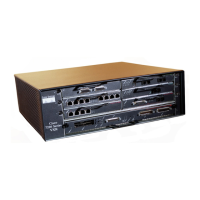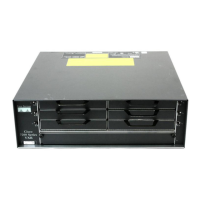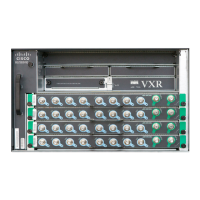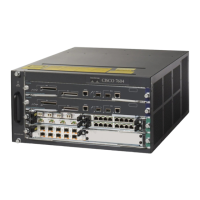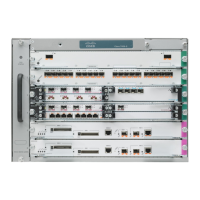33
At any point you may enter a question mark '?' for help.
Use ctrl-c to abort configuration dialog at any prompt.
Default settings are in square brackets '[]'.
Basic management setup configures only enough connectivity for management of the system, extended setup
will ask you to configure each interface on the system.
Step 3 When asked if you want to enter the basic management setup, enter no.
Would you like to enter the basic management setup [yes/no]: no
Step 4 When asked if you want to enter the initial configuration dialog and see the current interface summary, enter yes or
press Return:
First, would you like to see the current interface summary? [yes]:
In the following example, the summary shows a Cisco 7201 router at first-time startup; that is, nothing is configured.
Interface IP-Address OK? Method Status Protocol
FastEthernet0/0 unassigned NO unset up up
GigabitEthernet0/0 unassigned NO unset up up
GigabitEthernet0/1 unassigned NO unset up up
GigabitEthernet0/2 unassigned NO unset up up
GigabitEthernet0/3 unassigned NO unset up up
Step 5 Choose which protocols to support on your interfaces. For Internet Protocol (IP)-only installations, you can accept the
default values for most of the questions. A typical configuration using IP,
IPX, and AppleTalk follows and continues
through Step 10:
Configuring global parameters:
Enter host name [Router]:
Step 6 Enter enable secret, enable, and virtual terminal passwords:
The enable secret is a password used to protect access to privileged EXEC and configuration modes. This
password, after entered, becomes encrypted in the configuration.
Enter enable secret: barney
The enable password is used when you do not specify an
enable secret password, with some older software versions, and
some boot images.
Enter enable password: betty
The virtual terminal password is used to protect access to the router over a network interface.
Enter virtual terminal password: fred
Step 7 When asked whether you want to configure System Management, enter no.
Configure System Management? [yes/no]: no
Step 8 The Simple Network Management Protocol (SNMP) is the most widely supported open standard for network
management. It provides a means to access and set configuration and run-time parameters of routers and
communication servers. SNMP defines a set of functions that can be used to monitor and control network elements.
Enter yes or press Return to accept SNMP management; enter no to refuse it:
Configure SNMP Network Management? [yes]: no
Community string [public]:

